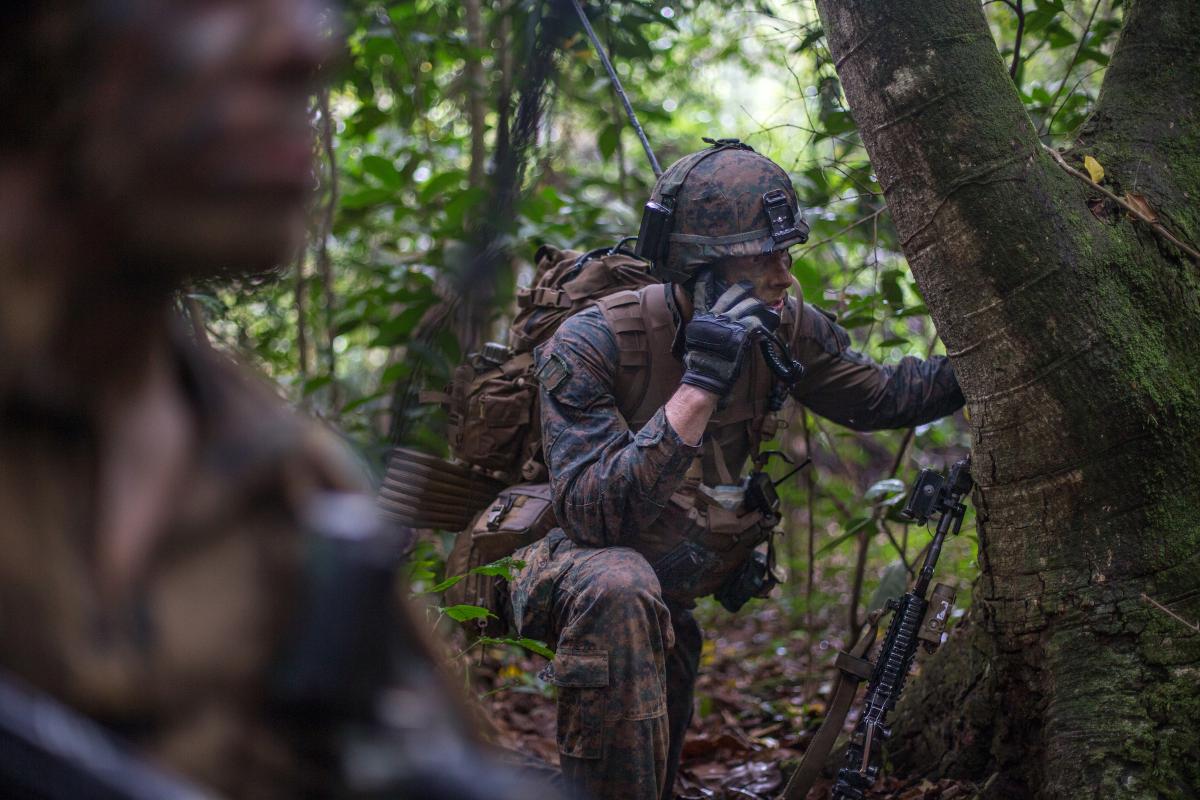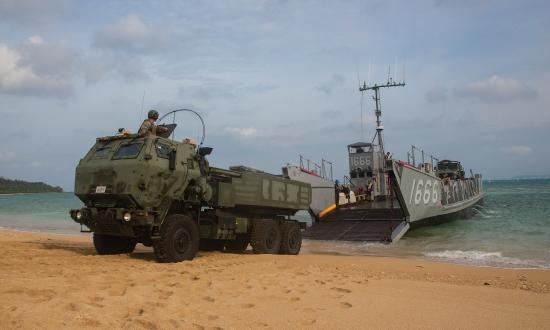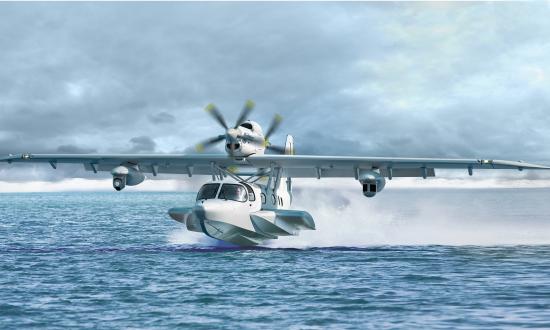In his Commandant’s Planning Guidance issued in July 2019, General David H. Berger answers the question “What does the Marine Corps provide the Navy and the Joint Force?” with expeditionary advanced base operations (EABO). But he could have also said “provide the ‘eyes’, ‘ears’, and ‘mouth’ for EABs,” including the Navy and the joint force. Short duration EABs providing command and control (C2), fuel, armament, and shooting options inside an adversary’s weapons engagement area present a solution; however, these EABs require their own C2. Facing an adversary that can challenge the Marine Corps in all domains, the Marine Corps must be prepared to provide C2, sustain losses, and thrive.
The multiple types of EABs require the ability to sense and communicate without being detected, identified, or targeted. As soon as the EABs emit, they will be targeted. The EABO concept (and support for it) also needs to focus on low-cost capabilities that provide survivability and redundancy. Deploying the C2 capability inside this engagement zone would present a prime target. The C2, or “brains,” must be able to operate in high threat areas with low-cost sensors to look and hear and communication tools to share.
Whether controlled by the Marine expeditionary force, a Navy composite warfare commander, or a joint or multinational commander, these EABs need to operate, sense, receive, and communicate information in an environment in which they are not protected by air or maritime dominance. The force commander must provide C2 for Marine Corps, naval, and joint aviation, ground, and maritime assets. Similar to the EAB commanders themselves, the force commander must significantly adapt to support the future force and provide recommendations for focused experimentation that exercises enabling capabilities to support the EABO concept.
Background
U.S. forces and the Marine Corps must operate in a contested environment. Then–Secretary of Defense James Mattis wrote in the 2018 National Defense Strategy, “For decades the U.S. has enjoyed uncontested or dominant superiority in every operating domain. We could generally deploy our forces when we wanted, assemble them where we wanted, and operate how we wanted. Today, every domain is contested—air, land, sea, space, and cyberspace.” To operate in these contested domains, the Marine Corps must also communicate. Mattis later noted in his book, Call Sign Chaos, “I also knew that our Achilles’ heel was overconfidence in uninterrupted communications. In a future war, these communications are certain to be broken. . . .We couldn’t become reliant on communication networks that will not be there when most needed.”1 These communication networks will be most needed in high-threat areas.
EABs will operate in such areas, often inside an adversary’s weapons engagement zone, and their survivability is based on the premise that they will be below the targeting threshold of adversary systems, thanks to their limited capabilities. But history and the forces of Parkinson’s Law will increase the tendency of capabilities to grow. Department of Defense acquisition systems and planners have historically tended to make robust, multi-capable platforms that become costly but also essential elements of combat power. As a result, despite planner, experimenter, and operational force intentions, natural forces push mission-focused EABs to expand their capabilities and footprint, which will increase the parameters an adversary will choose to target.
EABs require the ability to sense, communicate, and act. The Marine Corps will be tempted to integrate ground, aviation, and naval fires; air defense; close-air support; surveillance; as well as assault and logistics support in complex joint and coalition environments. Consequences of failure have significant adverse effects across the diplomatic, information, military, and even economic spectrum. This tendency to add greater capability to EABs, such as aviation C2, fuel, and armaments, increases because the need for that capability remains. But robust capability comes at a cost. The U.S. military acquisition process takes years, and the price of these exquisite systems is inordinate. The United States currently spends more on its military than any other country in the world—almost three times more than the second highest spender and almost as much as the rest of the world combined. Paying for more complex, exquisite systems is not the answer.
A Potential Solution
The Commandant’s Planning Guidance directly addresses this dilemma: “We must continue to seek the affordable and plentiful at the expense of the exquisite and few when conceiving of the future amphibious portion of the fleet.” Therefore, instead of deploying low-density, high-demand assets to provide a capability, the Marine Corps must deploy high-density, low-cost assets to support EABs. For the enabling functions of EABs, the requirement is to provide eyes (sea, air, ground, and/or cyber picture), ears (sensing and receiving), and mouth (communications, relay) to forward-based assets. Forward-basing these high-demand, low-density capabilities comes at a cost: The C2 enablers for the force commander—air-defense controllers, air-support controllers, datalink controllers, fires coordinators, intelligence representatives, system operators—each require Marines with months, if not years, of training and are at considerable risk when they deploy forward. The more robust the capability, the more protection required, and the more likely it will be targeted.
Supporting the EABs requires sending forward the eyes, ears, and mouth to high-threat zones, and keeping the C2 brain inside a protective umbrella. On the ground, the Marine Corps can deploy multistatic antennas, relays and relay antennas, remote sensors, and weapon systems. These ground-based systems can complement airborne, ship, and space-based relays and sensors.
Eyes: Highly capable radars can feed the kill chain by providing detection, targeting, and even assessment. However, once these radars radiate, they present a high payoff target for the adversary. As emitters, these active radars are a beacon that can be geolocated, requiring mobility and other means of active and passive defense measures. Passive and multistatic radars could provide robust, low-cost alternatives while still enabling situational awareness. Passive radars, also referred to as passive coherent radars (PCRs) or passive covert radars, are radar systems that detect and track objects by processing reflections of emitters from the environment, such as commercial broadcast (television and radio, e.g.) and communication signals. Bistatic/multistatic radars incorporate antennas designed and employed specifically for the purpose of emitting from a location separate from the receiver. Passive radars offer a low-cost means of augmenting a common operational picture using already existing signals. And low-cost multistatic emitters placed throughout an area feeding a passive receiver would put an adversary in a dilemma, having to choose how many high-cost assets to deploy and defeat them.
Ears: The deployment of multiple antennas on the ground, as a complement to airborne and space-based layers, presents a listening opportunity. Every antenna that emits can also receive. With the Defense Advanced Research Projects Agency (DARPA) already testing programs such as RadioMap and DRAGONS to turn standard antennas into radio frequency sensors that direction-find, geolocate, and listen, deploying antennas throughout the battlefield presents an opportunity to have low-cost ears to determine an adversary’s order of battle or even use them as jammers.
Mouth: Sending forward expendable antennas, or using host-nation antennas, enables communication from a far-reaching brain to assets going forward. Current communication relies on a layered approach that includes satellites, airborne relays, and potentially ship-based assets. The capability to talk to an aircraft, control an unmanned system, or coordinate with ground/surface–based assets already exists. However, these communication assets present ideal targets. Deploying a small team of Marines to install radio relays lowers risk and increases gain, when compared with sending a more robust capability. Deploying multiple interlinked and isolated antennas gives the adversary a difficult target while expanding the ability for EABs to communicate. No adversary can continually target multiple antennas throughout a large contested area with costly long-range missiles. When they do destroy some, the antennas can simply be replaced.
Forward deploying antennas, emitters, sensors, and shooters creates a reliance on communication reach back. This reliance can be mitigated by multiple means, including leveraging host nation infrastructure, including internet, mesh networks, and nodal relays—such as through multiple linked nodes, tropospheric communications, protected satellite communications, and other low probability of intercept/low probability of detection communication forms currently in developmental or experimental phases. This reach-back communication requirement is present for all EABs, with the more robust capabilities generally requiring greater bandwidth.
Relying any one type of system also presents risk. Using host-nation assets can mitigate that risk by offering a similar capability without the requirement for emplacement. The United States deploys worldwide and conducts theater security cooperation with other nations, often with intangible benefits. Mutual trust is built; however, that trust is temporary. New leaders or clashing personalities can destroy it. Relying on a mutual-defense system, such as sharing of required radar or communication assets, can cement that trust through mutual reliance. At the same time, nations deploy capabilities to defend themselves. They have air-traffic and air-defense radars as well as emergency communications systems. Shared use can support both the United States and the host nation. It also provides added capability with the ability to have better “eyes, ears, and mouth” in a contingency environment. Further, the possibility of destruction of host-nation equipment increases the stakes of conflict, serving as a potentially de-escalatory element.
Using remote sensing and communication capabilities, the Marine Corps and joint partners can exercise command and control from protected environments, reducing the risk not only from adversary targeting, but also the inherent risk of both detection and safety that comes from movement. Multistatic radars, or systems that have multiple transmitters spread throughout the area and a passive receiver at another location, present low-payoff targets. Loss of one transmitter can have a limited effect on the overall system. Having antennas spread throughout the observation area presents a multitude of low-cost targets that will take an adversary considerable time to defeat. Using host nation and allied systems can also increase the capability without deploying assets.
When the Marine Corps deploys these low-cost eyes, ears, and mouth forward, they can support not only EABs, but also naval, joint, and coalition forces.
1. James N. Mattis and Bing West, Call Sign Chaos: Learning to Lead (New York, NY: Random House, 2019), 156.






